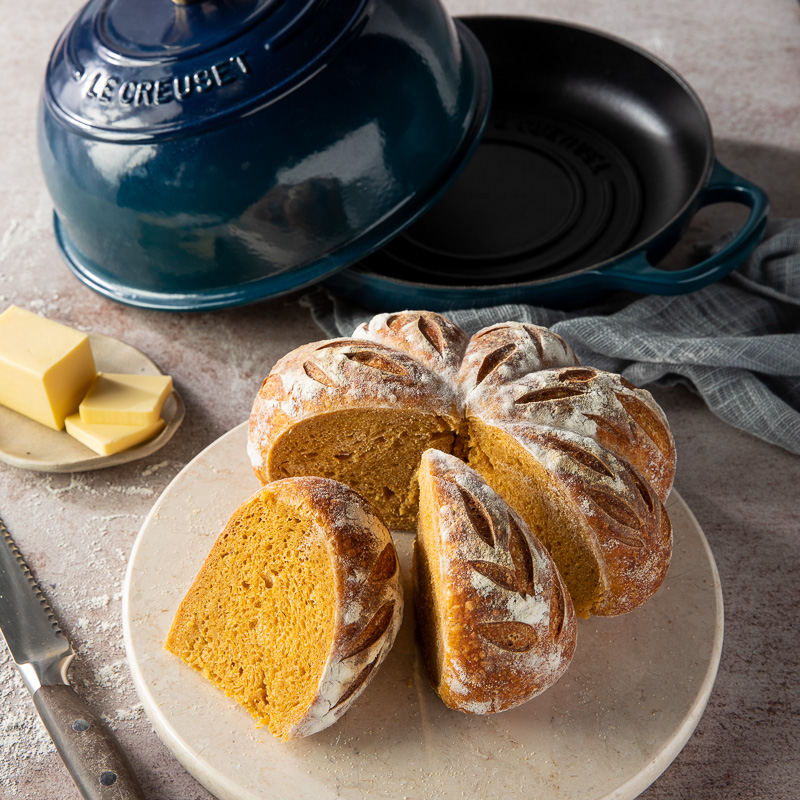
The ultimate seasonal centerpiece, our Pumpkin Sourdough Loaf is full of wonderfully festive flavors and irresistible charm. Baked in the Le Creuset Specie Oven, there’s simply not flipside torch increasingly seasonally inspired than this. Pumpkin not only flavors the specie but moreover enriches and hydrates the dough to create a loaf with a soft talc and delicately well-done crust. Accented with pumpkin pie spice, this sourdough loaf is full of subtle layers of flavor. Plus, Le Creuset’s legendary tint iron delivers superior heat distribution and retention while its domed lid ensures spanking-new steam-trapping power and maximum rise. Shaped with twine and artfully scored, this beautifully shaped specie is the ultimate showstopping bake.

The Le Creuset Specie Oven will make all your bread-baking a little uneaten special. Oven-safe up to 500°F; easy-to-clean durable porcelain enamel that resists dulling, staining, chipping, and cracking; and unmatched in heat and steam distribution without hot spots, this expertly crafted piece is sure to be bakers’ new weightier friend. With the Le Creuset Specie Oven, a well-done husks and delicate, zappy talc are easier to unzip than overly before. It’ll finger like an heirloom piece from the day you start sultry with it, and a staple of all your bread-baking memories for generations to come.
- Levain:
- 2 tablespoons (33 grams) levain
- ½ cup (120 grams) lukewarm water (85°F/29°C to 90°F/32°C)
- ¾ cup (95 grams) specie flour
- 3 tablespoons (24 grams) whole wheat flour
- Dough:
- 3 cups (381 grams) specie flour
- ½ cup (63 grams) whole wheat flour
- 1½ teaspoons (3 grams) pumpkin pie spice
- 1 cup (244 grams) canned pumpkin
- ⅓ to ½ cup (80 to 120 grams) lukewarm water (85°F/29°C to 90°F/32°C)
- 1 tablespoon (9 grams) kosher salt
- ½ cup (134 grams) levain
- Semolina flour, for dusting
- In a medium bowl, place 2 tablespoons (33 grams) levain. Add ½ cup (120 grams) lukewarm water. Add flours, and stir thoroughly with spoon or hands until smooth and no dry shit of flour remain. Loosely imbricate and let stand at room temperature overnight (or for 8 to 12 hours surpassing you plan to use).
- For dough: In a large bowl, stir together flours and pie spice. Add canned pumpkin and ⅓ cup (80 grams) water, and stir until a rough dough forms. Knead in trencher until no dry shit remain, 30 seconds to 1 minute. (If dough isn’t coming together without 30 seconds, slowly add remaining water, 1 tablespoon [15 grams] at a time, until flour is hydrated but isn’t super sticky. How much water you use will depend on the humidity at the time of mixing. Dough will not be smooth.) Imbricate and let stand (so flours can hydrate) for 20 to 30 minutes.
- Sprinkle dough with salt. Add ½ cup (134 grams) levain. (See Notes.) Using your hand, pinch and squeeze dough (this is not kneading) to help incorporate levain into dough until cohesive and uniform in texture, well-nigh 3 minutes. (Dough will not be smooth.)
- Cover dough, and let rise in a warm, draft-free place (75°F/24°C) for 1 hour and 20 minutes, folding dough in trencher every 20 minutes. (To well-constructed a fold, grab underside of dough, stretch it up, and fold it to part-way of dough. Do this 4 times virtually the trencher and then turn dough over so folds are facing down.) (At the end of folding, dough will be smooth and rubberband and pass the windowpane test; see Notes.) Let rise until doubled in size, dough jiggles when trencher is tapped lightly, and dough passes finger wafer test, 1½ to 2½ hours. (See Notes.)
- For final shape, turn out dough onto a lightly floured surface. Using your fingertips, gently printing dough into a 1-inch-thick circle. Stretch out marrow third of circle, and fold to center. Stretch right side out, and fold right third over to center; repeat with left side. Finish by folding top third over previous folds. Roll dough yonder from you to seam side down, and using both hands, cup dough and pull it toward you to seal. Rotate dough 90 degrees, and pull then until a tight, smooth boule forms, 5 to 7 times. Place, seam side up, in a banneton (proofing basket) or a small trencher lined with a kitchen towel heavily dusted with specie flour. Loosely imbricate dough with towel, and let rise in a warm, draft-free place (75°F/24°C) until puffed, dough jiggles when trencher is tapped lightly, and dough passes finger wafer test, 1½ hours to 2½ hours. (See Notes; alternatively, imbricate and refrigerate to cold-ferment overnight. Let stand at room temperature for 1 hour surpassing baking.)
- Preheat oven to 425°F (220°C).
- Cut 4 (24-inch) long strings of butcher’s twine. Lay them in a star insemination over wiring of Le Creuset Specie Oven. Dust dough with semolina flour; thoughtfully place dough on top of strings, rearranging them as needed.
- Making sure strings are equidistant, wrap each piece of string virtually loaf from marrow to top, and tie in part-way of top. Cut off glut strings. Using a lame or sharp paring knife, score dough in a leaf pattern in each section between strings. Imbricate wiring with lid, and place in oven.
- Bake for 30 minutes. Uncover and torch until deep golden brown and an instant-read thermometer inserted in part-way registers 205°F (96°C) to 210°F (99°C), 15 to 20 minutes more. Immediately remove loaf from Specie Oven, and let tomfool completely on a wire rack. Cut off strings surpassing serving.
To use the windowpane test to trammels dough for proper gluten development, lightly flour hands and pinch off (don’t tear) a small piece of dough. Slowly pull the dough out from the center. If the dough is ready, you will be worldly-wise to stretch it until it’s thin and translucent like a windowpane. If the dough tears, it’s not quite ready. Let stand for 20 minutes, perform flipside fold, and test again.
To use the finger wafer test, lightly flour the surface of the dough, and gently printing your finger well-nigh ½ inch into the surface. If your dough has properly fermented, you should be worldly-wise to watch the dough spring when slightly but still show an indentation. If the wafer disappears, the dough is underproofed and needs increasingly time.
The post Pumpkin Sourdough Loaf appeared first on Bake from Scratch.














